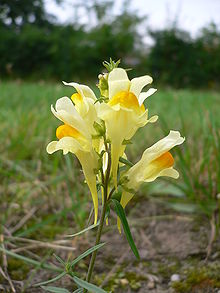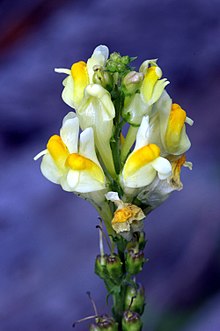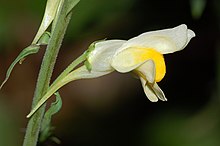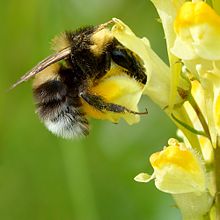Real toadflax
| Real toadflax | ||||||||||||
|---|---|---|---|---|---|---|---|---|---|---|---|---|

Toadflax ( Linaria vulgaris ) |
||||||||||||
| Systematics | ||||||||||||
|
||||||||||||
| Scientific name | ||||||||||||
| Linaria vulgaris | ||||||||||||
| Mill. |
The common toadflax ( Linaria vulgaris ) is a species of toadflax ( Linaria ). Other German-language common names are common toadflax , common toadflax , little snapdragon and woman flax .
description
Vegetative characteristics
The true toadflax is a perennial, herbaceous plant and reaches heights of 20 to 40, rarely up to 80 centimeters. The round, upright, unbranched stems in cross-section or slightly branched at the base or in the inflorescence area are glabrous or hairy with weak glands on top.
The sessile, bare, thin leaves are 2 to 5 centimeters long and 1.0 to 1.5 millimeters wide and linear-lanceolate with one to three nerves.
Generative characteristics
5 to 30 flowers are in a sometimes one-sided, racemose inflorescence . With a length of 2 to 8 millimeters, the flower stalk is about as long as the calyx and is often hairy with glands.
The hermaphrodite flowers are 19 to 33 millimeters long and zygomorphic with a double flower envelope . The cup is 3 to 6 millimeters long. The corolla has a 10 to 30 millimeter long, straight to slightly curved spur. The corolla is yellow, light sulfur yellow, with a strong yellow lower lip bulge and an orange-yellow spot on the lower lip. The flowering period extends from May to October.
The capsule fruits are ovate-spherical with a length of 5 to 11 millimeters and a diameter of 5 to 7 millimeters. The fruit ripens between July and September. The 2 to 3 millimeters long seeds are winged broadly.
The number of chromosomes is 2n = 12.
ecology
The true toadflax is a root-bud geophyte or hemicryptophyte with roots up to 1 meter deep . Vegetative propagation occurs through runners and root shoots.
From an ecological point of view, it is a matter of "real mask flowers". The flowers are rich in flavones and therefore yellow. The lower lip is pressed against the upper lip by a springy joint and can only be opened by bumblebees and larger wild bees . The flower is therefore called a "power flower". The hair bulges on the lower lip are a seal and guide line to the nectar, which is located in the 10 to 13 millimeter long petal spur. The flowers are homogeneous but self-sterile . Pollinators are particularly bumblebees and other long-nosed bees, and butterflies also get the nectar with the help of their narrow probes. Earth bumblebees commit “bloom collapse” by biting open the spur.
The mutant "Peloria", which has a radially symmetrical instead of a zygomorphic flower, has five instead of four stamens, and in which all five petals are spurred is impressive . Because of the strong external deviation, Carl von Linné placed this mutant in its own genus Peloria . Genetically, however, the only difference is that in the mutant, a gene is blocked by methylation of a single DNA component .
As pore capsules, the fruits are wind and animal shakers. The flat, skin-rimmed seeds spread like gliders and watery ones, but ants also spread. There is a rich seed production of up to 32,000 seeds per plant.

Occurrence
The true toadflax is a so-called apophyte in Central Europe , as the species originally native to the coastal vegetation changed to anthropogenic locations when forests were cleared by humans in Central Europe about 7,000 years ago to make space for fields. These locations were more open than most natural ones, were regularly disturbed and thus offered the true toadflax optimal living conditions. In the Allgäu Alps in Warmatsgundtal in Bavaria it rises to an altitude of 1320 meters.
Toadflax is often found on warm embankments. This species is a typical rubble plant, it loves loose, stony and sandy soil. It occurs in societies of the classes Agropyretea, Epilobietea angustifolii, Thlaspietea rotundifolii, Secalietea, Sedo-Scleranthetea or the order Onopordetalia acanthii.
Systematics
The Basionym Antirrhinum linaria L. was first published in 1753 by Linné in Species Plantarum . Philip Miller placed it in the genus Linaria in 1768 and named it with the nomen novum Linaria vulgaris Mill.
Two subspecies can be distinguished from Linaria vulgaris :
- Linaria vulgaris Mill. Subsp. vulgaris
- Linaria vulgaris subsp. perrieri (Rouy) Rouy : It occurs in France .
Common names
The names Dorant, Druut ( Mecklenburg ), fig leaf herb, fig herb, wild flax, flax, Wille flax ( Göttingen ), women flax ( Silesia , Mark, East Prussia ), urinary herb, heather flax are or were for the true toadflax , dog head Hunthaubito ( althochdeutsch ), Catherine flowers (Silesia), Catherine flax ( axes ), Catherine herb (axes), Krottenflachs, lamb herb Leinkraut , Linkraut (Mecklenburg), Wäld Liwemeltcher ( Transylvania ), Marie flax (Silesia), a wall flax, navel herb Schänndegräber ( Eifel near Altenahr ), shit herb, stable herb (in the sense of urine weed), cane herb, tackled herb (Mecklenburg), takenkraut (Silesia), uchleinkraut, our women flax and our woman har common.
swell
- Dietmar Aichele, Marianne Golte-Bechtle: What is blooming there? Wild flowering plants of Central Europe . 54th edition. Franckh-Kosmos, Stuttgart 1991, ISBN 3-440-05615-5 .
- Margot Spohn, Marianne Golte-Bechtle: What is blooming there? The encyclopedia: over 1000 flowering plants from Central Europe. Kosmos, Stuttgart 2005, ISBN 3-440-10326-9 .
- AO Chater, B. Valdés, DA Webb: Linaria Miller . In: TG Tutin, VH Heywood, NA Burges, DM Moore, DH Valentine, SM Walters, DA Webb (eds.): Flora Europaea . Volume 3: Diapensiaceae to Myoporaceae . Cambridge University Press, Cambridge 1972, ISBN 0-521-08489-X , pp. 226–236 (English, limited preview in Google Book Search).
Individual evidence
- ↑ a b c d e f g h i j Linaria vulgaris Mill., Ordinary toadflax. In: FloraWeb.de.
- ↑ a b c d e f g Ruprecht Düll , Herfried Kutzelnigg : Pocket dictionary of plants in Germany and neighboring countries. The most common Central European species in portrait . 7th, corrected and enlarged edition. Quelle & Meyer, Wiebelsheim 2011, ISBN 978-3-494-01424-1 , p. 461-462 .
- ↑ a b Erich Oberdorfer : Plant-sociological excursion flora for Germany and neighboring areas . With the collaboration of Angelika Schwabe and Theo Müller. 8th, heavily revised and expanded edition. Eugen Ulmer, Stuttgart (Hohenheim) 2001, ISBN 3-8001-3131-5 , pp. 830 .
- ^ Helical Science , The Scientist, September 1999, Notebook
- ↑ Erhard Dörr, Wolfgang Lippert : Flora of the Allgäu and its surroundings. Volume 2, IHW, Eching near Munich 2004, p. 435.
- ↑ Carl von Linné: Species Plantarum. Volume 2, Lars Salvius, Stockholm 1753, p. 616 ( digitized version ).
- ^ Philip Miller: The Gardeners Dictionary. 8th edition. John & Francis Rivington, London 1768 (online).
- ↑ a b c Karol Marhold: Scrophulariaceae. , 2011: Datasheet Linaria vulgaris In: Euro + Med Plantbase - the information resource for Euro-Mediterranean plant diversity.
- ^ Georg August Pritzel , Carl Jessen : The German folk names of plants. New contribution to the German linguistic treasure. Philipp Cohen, Hannover 1882, pp. 34-35 (online).
Web links
- Linaria vulgaris agg., Species group common toadflax. In: FloraWeb.de.
- Profile and distribution map for Bavaria . In: Botanical Information Hub of Bavaria .
- Real toadflax . In: BiolFlor, the database of biological-ecological characteristics of the flora of Germany.
- Linaria vulgaris Mill. In: Info Flora , the national data and information center for Swiss flora .
- Distribution in the northern hemisphere from: Eric Hultén, Magnus Fries: Atlas of North European vascular plants. 1986, ISBN 3-87429-263-0 at Den virtuella floran. (swed.)
- Thomas Meyer: Toadflax data sheet with identification key and photos at Flora-de: Flora von Deutschland (old name of the website: Flowers in Swabia ).
- Global Invasive Database : Linaria vulgaris
- Datasheet with photos at The Ecology of Commanster : Ecological Relationships Among More Than 5900 Species .
- Data sheet with photos at NatureGate .
- Pictures: inflorescence in detail by Walter Obermayer.






